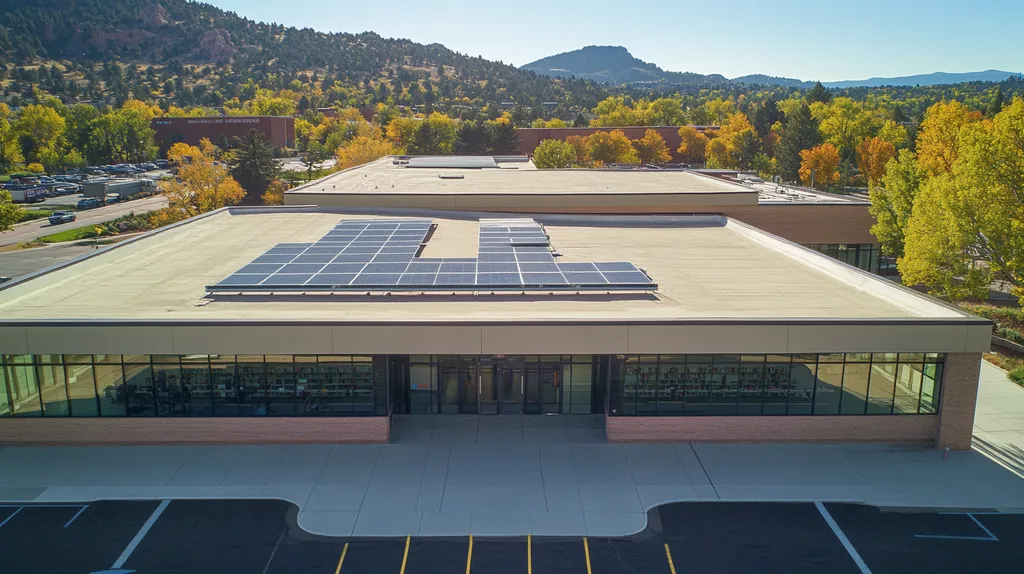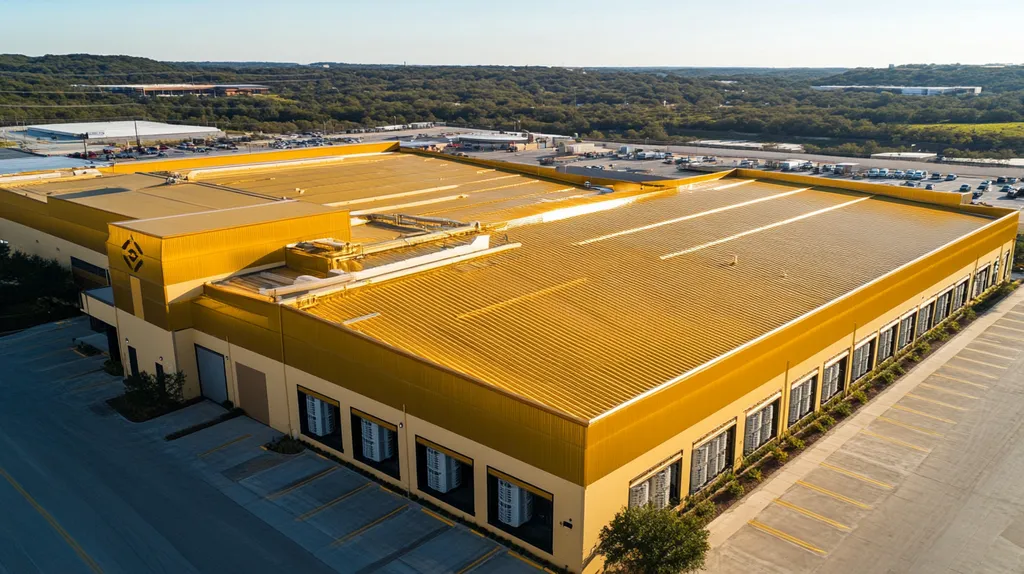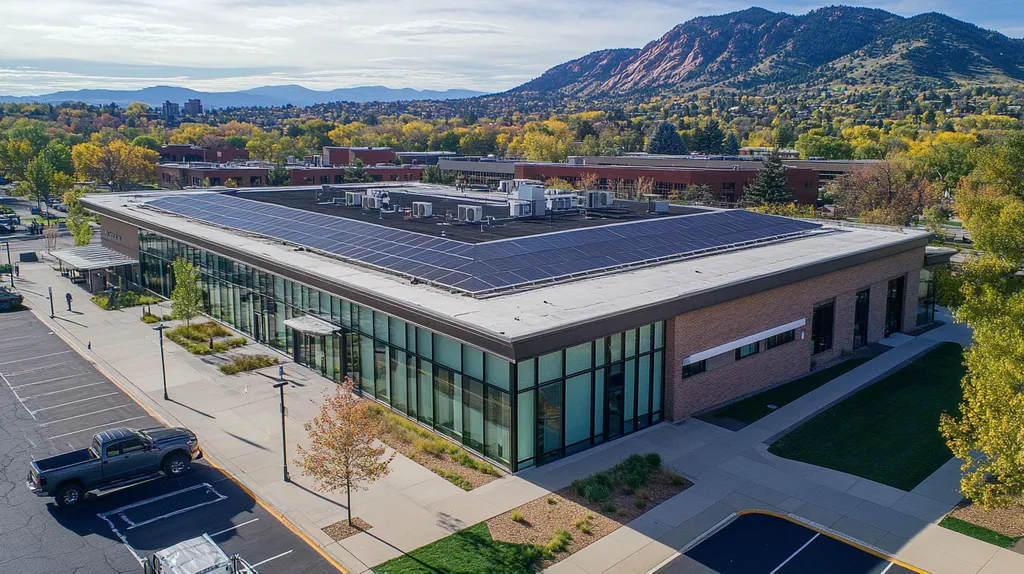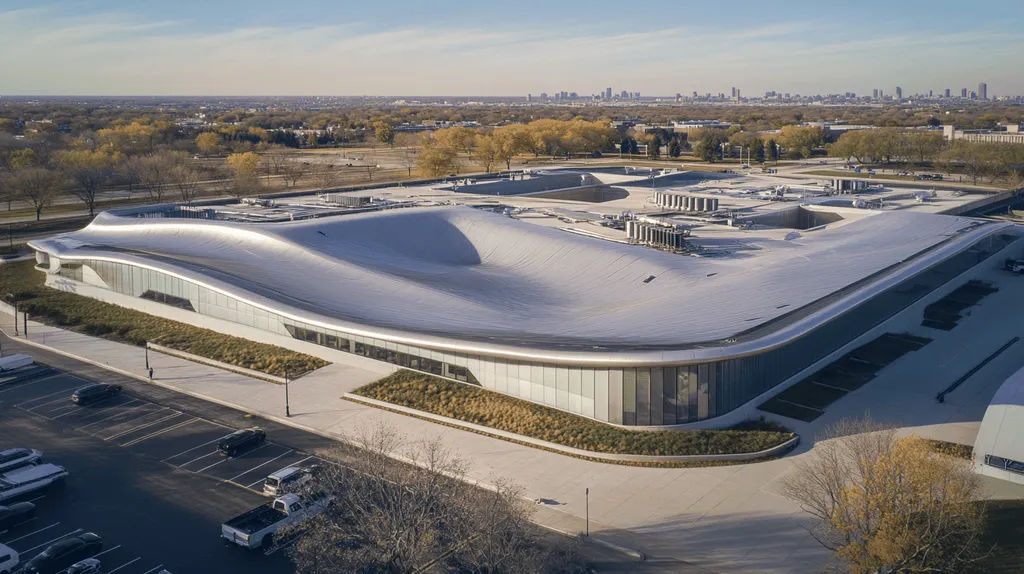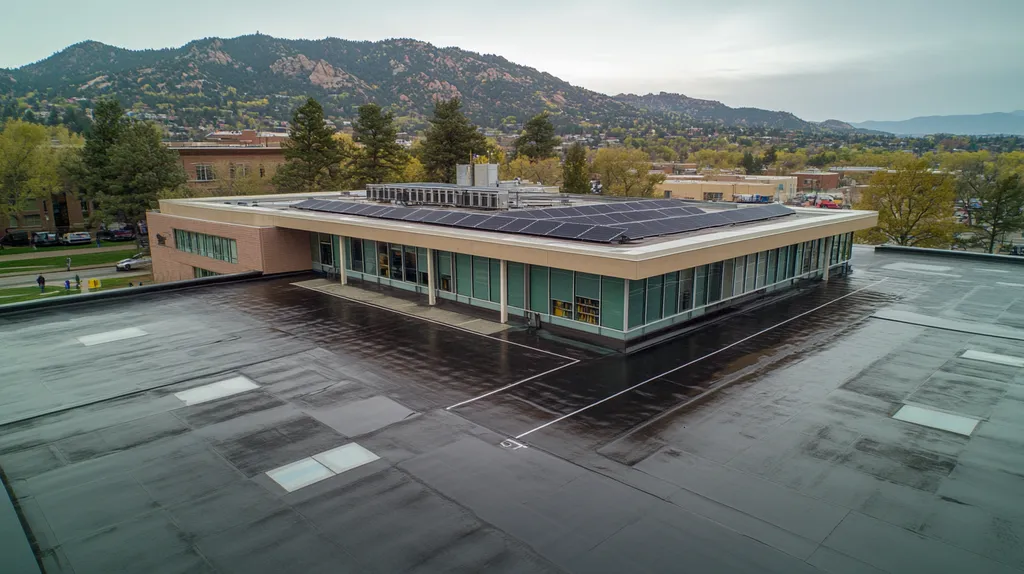Commercial property owners face a critical challenge: financing new roofs that average $250,000-$500,000 while navigating complex regulations and performance requirements. Industry data shows that 40% of commercial buildings will need roof replacement within the next five years.
With material costs rising 15% annually and stricter energy codes taking effect, choosing the right financing strategy has never been more crucial for protecting property value and operational budgets.
This comprehensive guide examines key considerations across performance metrics, funding options, compliance demands, and risk management to help property professionals make informed roofing investment decisions.
SECTION 1: PERFORMANCE FACTORS
Investing in a new commercial roof is not a decision to be taken lightly. With costs averaging between $250,000 and $500,000, understanding aspects such as longevity, energy efficiency, and design is crucial. Ignoring these performance factors could result in unnecessary expenses down the road and inflated operational costs.
Assessing Roof Material Longevity and Durability
Selecting the right roofing material is key to maximizing a commercial property’s long-term value. Options like TPO, EPDM, and metal roofing offer impressive lifespans ranging from 15 to 50 years, making them solid investments in durability. On the other hand, opting for cheaper materials can lead to replacements in as little as 10 years, raising overall ownership expenses.
Long-lasting materials often include warranties that can positively impact financing options. Lenders may categorize durable materials as lower risk, potentially enabling better financing terms. Furthermore, high-performance roofs generally require less maintenance, justifying their higher initial investment.
Property owners should also factor in local climate and building uses when making material choices. For instance, a roofing system in an area with high UV exposure might benefit from reflective coatings to enhance durability. Making informed material selections can lead to substantial long-term savings.
Key Action Items
Evaluating Energy Efficiency and Insulation Benefits
Energy efficiency plays a pivotal role in determining the financial feasibility of a new roof. Commercial roofs that boast superior insulation can lead to significant reductions in heating and cooling costs, with the U.S. Department of Energy reporting potential savings of up to 30% on annual energy bills.
Choosing reflective roofing materials, such as white TPO or modified bitumen, helps control heat absorption while reducing the urban heat island effect. This can lead to a decrease in energy consumption during peak seasons, positively influencing monthly operational costs.
Energy efficiency is an essential topic in financing discussions. Lenders often view properties with lower energy expenses as more valuable, which can result in favorable interest rates. Property owners are encouraged to explore energy incentives or rebates that may accompany upgrades to energy-efficient roofing.
Key Action Items
Impact of Roof Design on Financing and Performance
The roof’s design, including its slope and drainage systems, critically impacts performance and financial aspects. A well-engineered roof promotes effective drainage, preventing water buildup that could compromise longevity. In contrast, poorly designed roofs may face premature failures, incurring costly repairs.
Additionally, roof design can shape available financing options. Unique structures, such as green roofs or complex designs, might be eligible for specialized funding or grants focused on sustainability. An appealing roof design can enhance aesthetics while potentially increasing property value.
Integrating future features, such as solar panels or rooftop gardens, into the initial design can extend a property’s innovative and sustainable appeal. Successfully implementing these elements can attract investments and improve financing conditions, emphasizing the necessity of understanding design implications.
Key Action Items
SECTION 2: FINANCIAL CONSIDERATIONS
Financial considerations are crucial when investing in a new commercial roof, as they directly impact a property’s bottom line. With costs ranging from $10,000 to $500,000 based on size and materials, understanding various financing options is essential. The right funding can be the difference between a thriving asset and financial strain. This section will delve into loan options, the pros and cons of leasing versus purchasing, and available grants and incentives.
Comparing Loan Programs and Interest Rate Structures
Property owners have several loan programs to help manage the costs of a new roof. Options range from traditional banking loans to specialized financing offered by roofing contractors. Interest rates can vary between fixed and variable, with each affecting overall affordability.
Fixed-rate loans provide consistent monthly payments, aiding long-term budgeting, while variable-rate loans may start lower but can fluctuate, potentially increasing costs in the future. Therefore, it’s essential to thoroughly evaluate each loan type.
In addition, lenders may offer loans that specifically support energy-efficient improvements, often at lower interest rates due to their long-term savings potential. Carefully reviewing the total cost of various loan programs, including fees and penalties, is vital for ensuring a financing strategy that aligns with the property’s budget.
Key Action Items
Leasing vs. Purchase: Cost Implications and Cash Flow
The decision between leasing or purchasing a new roof has significant implications for both cash flow and long-term financial impact. Leasing tends to require lower upfront costs, making it a viable option for property managers seeking immediate solutions. However, leasing may result in higher total costs over time.
In contrast, purchasing a roof outright provides ownership and potentially increases property value. While this option requires more capital initially, it can offer valuable tax benefits that offset some of the costs. Understanding these financial factors is crucial for cash flow management.
Some lease agreements may also include maintenance and repair services, relieving property managers of those responsibilities. It’s essential to assess overall costs, including ongoing operational expenses, when comparing leasing and purchasing options.
Key Action Items
Accessing Grants, Incentives, and Vendor Financing
Many property owners overlook valuable grants and incentives designed to reduce roofing expenses. Local and federal programs often encourage energy efficiency and sustainability, such as the Federal Energy Efficiency Tax Credit for qualifying roofing systems.
Moreover, roofing manufacturers and contractors frequently provide vendor financing options, making roof upgrades more financially feasible and competitively priced. Understanding the fine print on these options can help property managers make informed decisions and conserve cash flow.
Additionally, utility companies may offer incentives for adopting energy-efficient roofing systems. Working with a knowledgeable roofing contractor can help uncover these funding opportunities, fostering significant financial savings.
Property managers should also stay informed about changing regulations and potential new incentives. Regularly reviewing funding sources can reveal emerging opportunities that align with financial goals.
Key Action Items
SECTION 3: COMPLIANCE REQUIREMENTS
When investing in a new commercial roof, adhering to local building codes and regulations is non-negotiable. Non-compliance can lead to fines and project delays, impacting timelines and budgets. In fact, over 30% of roofing projects encounter unexpected costs due to regulatory oversights, underscoring the importance of compliance for securing financing and ensuring successful project outcomes.
Understanding Building Codes and Roofing Standards
Building codes and roofing standards vary by region and play a crucial role in project planning. Familiarity with applicable codes can save time and resources, as some areas may mandate specific materials or installation methods tailored to local weather patterns.
Neglecting to comply with these codes can result in rejected permits or hefty penalties. Property managers may underestimate the value of hiring a roofing contractor well-versed in local regulations, guaranteeing adherence from start to finish.
Furthermore, building codes can change over time, making it essential for facility managers and property owners to stay updated. Engaging with a certified roofing professional enhances compliance knowledge and aligns projects with industry best practices, boosting long-term performance.
Key Action Items
Navigating Environmental and Energy Efficiency Regulations
Environmental regulations are tightening across many jurisdictions, making compliance essential for sustainability and financing eligibility. Roofing systems that meet ENERGY STAR requirements can qualify for valuable rebates, thus incentivizing energy efficiency.
Many property owners overlook the benefits of green roofing solutions, which reduce environmental footprints and lower energy costs. For example, cool roofs that reflect sunlight can significantly decrease cooling expenses during hotter months.
Understanding local, state, and federal energy codes can help property owners access financial incentives and tax credits, enhancing return on investment. Compliance not only avoids fines but also increases the likelihood of securing financing from lenders who prioritize sustainable practices.
Key Action Items
Documentation and Approval Processes for Financing
Securing financing for a new roof requires meticulous documentation, which can be complex and time-consuming. Property owners must prepare detailed project proposals accompanied by proof of compliance. Incomplete documentation often leads to financing delays or denials.
Financial institutions typically demand evidence of adherence to local building codes and environmental regulations. Submitting inaccurate or insufficient information can significantly hinder the approval process. A comprehensive financing application signals commitment to compliance.
Working alongside an experienced roofing contractor can streamline approvals. Contractors familiar with lender requirements can assist property owners in compiling necessary documents, reducing chances of oversight and enhancing the likelihood of funding approval.
Key Action Items
SECTION 4: RISK MANAGEMENT
A new commercial roof represents a significant investment, and the potential pitfalls are substantial. Inadequate planning can lead to early roof failure or unforeseen expenses, with the National Roofing Contractors Association (NRCA) reporting that nearly 10% of new roofs fail within the first few years. This section will explore key risks linked to roof failure, the role of insurance coverage, and effective contingency planning strategies.
Identifying Roof Failure and Warranty Risks
Recognizing the risks of roof failure is essential for property owners. Common problems arise from improper installation, inferior materials, and weather-related impacts. Alarmingly, statistics show that over 30% of commercial roofing failures can be attributed to incorrect installation practices.
While warranties are designed to protect investments, property managers often neglect their critical role. Common warranty coverage includes materials but often excludes installation. Therefore, it’s essential to ensure both elements are well-documented and compliant with local regulations.
To prevent unexpected failures, integrating regular inspections and maintenance into management practices is vital. Scheduling these assessments can help detect vulnerabilities early, saving on costly repairs and extending the roof’s lifespan.
Key Action Items
Insurance Coverage and Claim Financing Options
Navigating insurance policies is essential for protecting this significant investment. Although standard property insurance may cover certain roof damage, not all situations are included. Property owners must understand their policy’s specifics to avoid unexpected costs down the line.
To enhance protection, consider specialized roofing insurance, which addresses risks like aging and weather damage. This coverage can be tailored specifically for the nuances of roofing-related issues.
Additionally, knowing the ins and outs of claim financing can lighten the financial burden during roof failures. Being prepared enables owners to file claims promptly, offsetting costs associated with damages.
Key Action Items
Contingency Planning for Project Delays and Cost Overruns
Delays and cost overruns can significantly derail roofing projects, leading to financial strain. For instance, unforeseen weather conditions can push timelines back, thereby inflating labor costs. Effective contingency planning is crucial to mitigate these risks.
Allocate a budget specifically for unexpected expenses. Financial advisors recommend setting aside 10-15% of the initial project costs for contingencies to ensure funds are available for unplanned challenges.
It’s also vital to establish clear timelines and maintain open communication with contractors. This practice can alleviate risks associated with delays and maintain project alignment with the budget.
Key Action Items
SECTION 5: OPERATIONAL PROCEDURES
Effective timing is critical when securing financing for a new commercial roof. Delays in scheduling can lead to unexpected financial complications and missed opportunities. Industry reports indicate that poor financing coordination can inflate project costs by up to 20%. Establishing clear operational procedures is essential to align financing with project timelines, compliance standards, and contractor payments. This section will discuss strategies to streamline these processes and avoid potential pitfalls.
Coordinating Financing with Project Scheduling
Successful project scheduling hinges on timely financing decisions. Property owners and managers need to ensure funds are ready before critical roofing work commences, necessitating close collaboration with lenders and contractors to set payment milestones aligned with project phases.
One effective strategy is to develop a comprehensive project timeline that specifies when financing must be secured. Utilizing digital project management tools can enhance communication among stakeholders, keeping everyone informed and accountable. This proactive approach can minimize delays and foster stronger trust among all parties involved.
Additionally, reviewing financing options early will reveal any constraints that might affect scheduling. For example, if a loan has extensive documentation requirements, addressing these ahead of time can help prevent unnecessary holdups. Regular status meetings can also help maintain alignment throughout the process, allowing timely adjustments to be made in response to any changes.
Key Action Items
Verification Checklists for Quality and Compliance
Verification checklists are essential tools to ensure quality and compliance during the roofing project. These checklists validate that all financial arrangements comply with necessary legal and industry standards.
For compliance, property managers should collaborate with legal advisors to create checklists reflecting local regulations and funding requirements. This preparation can prevent costly fines and reinforce that the roofing project meets safety standards.
Quality verification is similarly important. Linking payment milestones to completion of specific work ensures it meets specifications before release of funds. This approach not only protects financial interests but also enhances the overall quality of the roofing system. Accurate documentation of these checks can support future warranty claims and maintenance efforts.
Key Action Items
Managing Contractor Financing and Payment Plans
It is crucial to manage contractor financing and payment plans effectively to ensure both parties meet their contractual obligations. Clear payment terms should be established before work commences, detailing the schedule and method of payments.
Negotiating favorable payment terms can benefit property owners; for instance, phased payments aligned with project milestones can ease financial strain and allow owners to assess the quality of work. This strategy also helps control cash flow effectively.
Incorporating contingencies into financing agreements is vital, as unforeseen issues may arise during the project. Having a financial buffer can help mitigate impacts on cash flow. Additionally, regular updates from contractors regarding project status can facilitate timely payments, and employing cloud-based systems can enhance this process with real-time data access.
Key Action Items
SECTION 5: OPERATIONAL PROCEDURES
Timing is crucial when securing financing for a new commercial roof. Delays in project scheduling can result in significant financial complications and missed opportunities, with inefficient financing tracking adding up to 20% in additional costs. Establishing robust operational procedures is essential for aligning financing with project timelines, compliance requirements, and contractor payments. This section examines strategies to streamline these processes and avert possible issues.
Coordinating Financing with Project Scheduling
Successful project execution is heavily dependent on timely financing decisions. Property owners and managers must ensure that funds are in place before critical phases of roofing work commence. This necessitates close collaboration with lenders and contractors to set payment milestones that align seamlessly with project phases.
A practical approach is creating a comprehensive project timeline that clearly outlines when financing must be secured. Utilizing digital project management tools can help ensure all stakeholders are informed and accountable. This proactive method not only minimizes delays but also fosters stronger trust among all parties involved.
Additionally, reviewing financing options early can unveil potential constraints that may impact scheduling. For example, if a loan requires extensive documentation, addressing these needs upfront can prevent unnecessary delays.
Regular status meetings throughout the process can further aid in maintaining alignment. These sessions allow for timely adjustments as project timelines or financial conditions shift.
Key Action Items
Verification Checklists for Quality and Compliance
Verification checklists are essential for ensuring quality and compliance throughout the roofing project. These tools help confirm that all financial arrangements align with necessary legal and industry standards.
To ensure compliance, property managers should collaborate with legal advisors to develop checklists that address local regulations and funding requirements. This preparation can prevent costly fines and ensure safety standards are met throughout the roofing process.
Quality verification is equally critical. Establishing payment milestones that correspond to completed work ensures it meets specifications before funds are released. This process protects financial investments while enhancing the overall quality of the roofing installation.
Thorough documentation of these compliance and quality checks is crucial. Keeping accurate records aids in final inspections and can support future warranty claims or maintenance efforts.
Key Action Items
Managing Contractor Financing and Payment Plans
Effectively managing contractor financing and payment agreements is vital for ensuring that all contractual obligations are met. Clear payment terms should be established prior to project commencement, detailing the schedule and method for payments.
Negotiating favorable payment arrangements can benefit property owners. For example, structuring phased payments tied to project milestones alleviates financial pressure. This strategy enables owners to assess the quality of work before releasing funds, thereby controlling cash flow.
It’s also crucial to include contingency provisions in financing agreements to address unforeseen issues that may arise during the project. Maintaining a financial buffer can help mitigate cash flow impacts.
Regular updates from contractors on project status are essential for facilitating timely payments. Utilizing cloud-based platforms for this communication can enhance transparency, providing real-time data accessible to all stakeholders.
Key Action Items
The Bottom Line
With 40% of commercial buildings requiring roof replacement in the next five years and costs rising 15% annually, property owners cannot afford to delay strategic financing decisions.
The complexity of modern roofing projects demands a comprehensive financing strategy that addresses performance metrics, regulatory compliance, and risk management protocols.
Property managers who leverage available financing tools – from traditional loans to specialized vendor programs – position themselves to maximize both short-term cash flow and long-term property value.
Success requires careful coordination between funding timelines, contractor schedules, and compliance requirements to avoid the 20% cost increases typically seen in poorly managed projects.
By implementing the action items outlined in this guide, property owners can secure optimal financing while ensuring their roofing investment delivers lasting value.
FREQUENTLY ASKED QUESTIONS
Q. What performance factors should I consider for a commercial roof?
A. Key performance factors include longevity, energy efficiency, and material durability. Choosing high-quality materials ensures long-lasting results and energy savings, while poor choices can lead to costly repairs and increased operational expenses.
Q. How do I compare financing options for a new commercial roof?
A. Compare loan programs focusing on interest rates and repayment terms. Evaluate fixed versus variable interest rates and assess energy-efficient loan options that can provide favorable financing terms based on potential long-term savings.
Q. What compliance requirements apply to commercial roofs?
A. Compliance with local building codes and environmental regulations is mandatory. Familiarize yourself with these codes to avoid fines and ensure project success, as a roofing contractor knowledgeable in regulations can aid in compliance.
Q. What are the risks of commercial roof failure?
A. Common risks include improper installation and using inferior materials. Regular inspections and understanding warranty coverage are crucial to mitigating potential failures and protecting your investment from costly repairs.
Q. How can I coordinate financing with project scheduling?
A. Ensure funds are secured prior to project commencement. Create a detailed timeline of financing milestones and engage in regular communication with lenders and contractors to minimize delays and maintain project alignment.
Q. What are effective strategies for managing contractor payments?
A. Establish clear payment terms before work begins, linked to project milestones. Negotiating phased payments can ease financial strain and ensure work quality is assessed before making full payments to contractors.
Q. What should I know about insurance for my commercial roof?
A. Understand your insurance policy’s coverage limits for roof damage. Consider specialized roofing insurance that addresses specific risks, and be familiar with the claims process to lighten financial burdens associated with roof failures.


